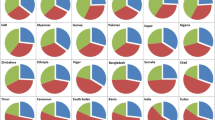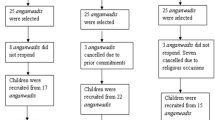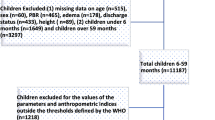Abstract
Objective: For years it has been shown that more children die from moderate malnutrition (MM) than severe. Till yet few studies deal specifically with identifying these children. This study attempts to statistically determine the appropriate anthropometric measures and cut-off points for diagnosing moderate malnutrition in preschool children.Methods: Anthropometric measurements were obtained from 609 preschool children from the cities of Adigrat, Ethiopia; Janampet, India; San Paulo, Brazil. The values were used to determine the sensitivity, specificity, positive predictive value (PPV) and likelihood ratio (LR) of each index studied. The optimum cutoff point for each index was considered to be the cutoff point with the maximum Kappa coefficient for efficiency. The McNemar Test for the significance of changes was used to determine if these findings were in agreement when applied to this data.Results: Weight for height (WFH) at each site had the highest PPV and LR of 4 but was not signficant by the McNemar Test. Mid-upper arm circumference (MUAC) in India had the same PPV (77%) as WFH but a LR of 2. MUAC in India, Brazil and Ethiopia tested significantly for the McNemar Test. The cut-off point for MUAC in India and Brazil was determined to be <15.5 cm in India and Brazil but was <15 cm in Ethiopia. Waist circumference in India tested a significantly PPV of 64%, and a LR of 2.Conclusion: These results show that WFH and MUAC could be used with WFA to identify the MM child. The cut-off points for MUAC may vary per location. WC positive data suggests further study is warranted. The McNemar findings yielded significant evidence that statistically determined indicators can be established to identify MM. With further study these methods may prove to be an important component in the efforts to improve child survival.
Similar content being viewed by others
References
UNICEF Progress since the World Summit for Children. April, 2002.
Fawzi WW, Herrera MG, Spigelman DL, El Amin A, Nestel P, Mohamed KA. A prospective study of malnutrition in relation to child mortality in the Sudan.American J Clinical Nutrition 1997; 65:1062–1069.
Yoon PW, Black RE, Moulton LH, Becker S. The effect of malnutrition on the risk for diarrhea and respiratory mortality in children < 2 years of age in Cebu, Philippines.Ame J Clin Nutrition 1997; 65:1070–1077.
Schroeder DG, Martorell R. Enhancing child survival by preventing malnutrition.Am J Clin Nutrition 1997; 65:1080.
Pelletier DL. The relationship between child anthropometry and mortality in developing countries: Implications for policy, programs and future research.Journal of Nutr 1994; 124, (10 Suppl) 2047s-2081s.
DeOnis M, Montero C, Akre J, Clugston G. The world-wide magnitude of protein-energy malnutrition: an overview from the WHO global data base on child growth.Bull WHO 1993; 71(6): 703–712.
Ojo O, Deane R, Amuna P. The use of anthropometric and clinical parameters for early identification and categorisation of nutritional risk in pre-school children in Benin City, Nigeria.The Journal of the Royal Society for the Promotion of Health 2000; 120(4): 230–235.
Oshaug A, Pedersen J, Diarra M, Bendech MA, Hatloy A. Problems and pitfalls in the use of estimated age in anthropometric measurements of children from 6 to 60 months of age: A case from Mali.Journal of Nutr 1994; 124 (5): 636–44.
Trowbridge FL, Hiner CD, Robertson A. Arm muscle indicators and creatine excretion in children.Am J Clin Nutr 1982; 36:691–696.
Siziya S, Matchaba-hove RB. Comparison of arm circumference against standard anthropometric indices using data from a high density town near Harare, Zimbabwe.Central Afr J Med 1994; 40(9): 250–254.
Sullivan K, Gorstein J. Programs for nutritional anthropometry. Chapter 23. Dean AD, Dean JA, Burton AH, Dicker RC. Epi Info, version 6: a word processing, database, and statistics program for epidemiology on microcomputers. Atlanta: US Department of Health and Human Services, Public Health Service, CDC, 1995.
Bairagi R, Suchindran CM. An estimator of the cut-off point maximizing sum of sensitivity and specificity. Sankhya. Series B.Indian J Statis 1989; 51: 263–269.
Siegel S.Nonparametic Statistics for the Behavioral Sciences. NY: McGraw Hill, 1988.
Lee GM, Harper MB. Risk of bacteremia for febrile young children.Arch Pediatr Adolesc Med 1998; 152: 624–628.
Briend A, Bari A. Critical assessment of the use of growth monitoring for identifying high risk children in primary health care programs.Brit Med Journal 1989; 298:1607–1611.
Schroeder DG, Brown KH. Nutritional status as a predictor of child survival: Summarizing the association and quantifying its global impact.Bull WHO 1994; 72(4): 569–579.
Technical Seminar — Anemia, Nutritional Status and Vitamin A Supplementation WHO Dept. of Child and Adolescent Health and Development, August 2001.
DeOnis M, Yip R, Mei Z. The development of MUAC-for age reference data recommended by WHO Expert Committee.Bull WHO 1997; 75:11–18.
Bodurtha JN, Mosteller M, Hewitt JK, Nance W, Moskowitz WB, Katz S, Schieken R. Genetic analysis of anthropometric measures in 11-year-old twins: The Medical College of Virginia twin study.Pediatr Research 1990; 28:1–4.
Tiret L, Ducimetiere P, Andre JL, Guegen R, Herbeth B, Spyckerelle Y, Rakotoavao R, Cambien F. Family resemblance in body circumferences and their ratios: The Nancy family study.Annals of Human Biology 1991; 3: 259–271.
Fleiss JL.Statistical Methods for Rates and Proportions. John Wiley & Sons, New York, 1973.
Chen LC, Alauddin Chowdbury, AKM. Anthropometric assessment of energy protein malnutrition and subsequent risk of mortality among preschool aged children.American J Clin Nutrition 1980; 33:1836–1845.
Author information
Authors and Affiliations
Corresponding author
Rights and permissions
About this article
Cite this article
Lloyd, M.E., Lederman, S.A. Anthropometry and moderate malnutrition in preschool children. Indian J Pediatr 69, 771–774 (2002). https://doi.org/10.1007/BF02723689
Issue Date:
DOI: https://doi.org/10.1007/BF02723689




